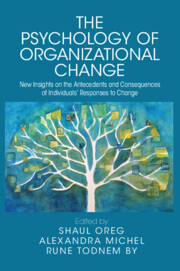 The Psychology of Organizational Change
The Psychology of Organizational Change Book contents
- The Psychology of Organizational Change
- The Psychology of Organizational Change
- Copyright page
- Contents
- Contributors
- Part I Introduction
- Part II The Evolution of Change and Its Responses
- Chapter 2 Preparing for Change Starts Now
- Chapter 3 The Role of Time in Organizational Change
- Chapter 4 Change Recipients’ Emotions during Organizational Change
- Part III Change in Context
- Part IV The Development of Change Leadership
- Part V The Process of Change Leadership
- Part VI Conclusions and Commentary
- Index
- References
Chapter 2 - Preparing for Change Starts Now
Intentions to Resist Future Changes
from Part II - The Evolution of Change and Its Responses
Published online by Cambridge University Press: 28 September 2023
- The Psychology of Organizational Change
- The Psychology of Organizational Change
- Copyright page
- Contents
- Contributors
- Part I Introduction
- Part II The Evolution of Change and Its Responses
- Chapter 2 Preparing for Change Starts Now
- Chapter 3 The Role of Time in Organizational Change
- Chapter 4 Change Recipients’ Emotions during Organizational Change
- Part III Change in Context
- Part IV The Development of Change Leadership
- Part V The Process of Change Leadership
- Part VI Conclusions and Commentary
- Index
- References
Summary
Employee resistance is often seen as the major force against the enactment of change. The literature has privileged the view that resistance, for the most extent, is the resistors’ own fault. As Ford and Ford put it, “the assumption is that they resisted a perfectly logical move.” I build on the approach that resistance to change is a form of feedback, to argue that, if organizations and their agents examine the underlying reasons, they will be better equipped to deal with the challenges related to resistance. In light of Uncertainty Reduction Theory, I also suggest that we need to move beyond the viewpoint that examines change as a one-off phenomenon and interpret it as grounded in the broader organizational life. Finally, and building on recent empirical evidence, I put forth a framework on anticipating intentions to resist future change that integrates the organization’s history of change, individual characteristics, leadership factors, and organizational factors, alongside important boundary conditions that influence the sensemaking process underlying the development of intentions to resist future changes.
Keywords
- Type
- Chapter
- Information
- The Psychology of Organizational ChangeNew Insights on the Antecedents and Consequences of Individuals' Responses to Change, pp. 15 - 41Publisher: Cambridge University PressPrint publication year: 2023
